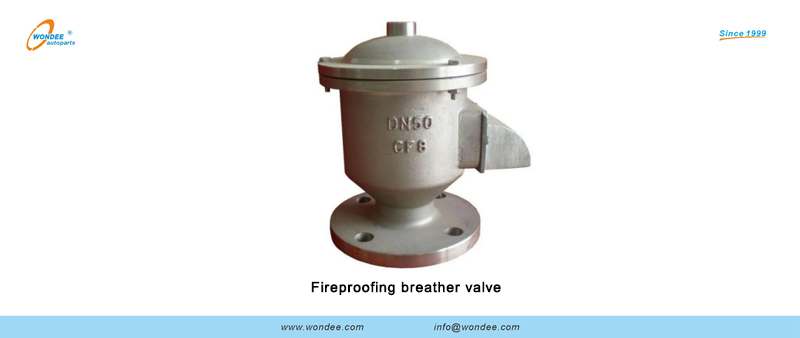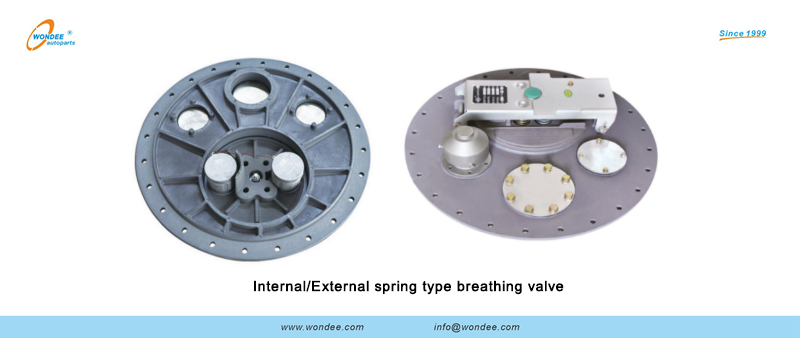Views: 0 Author: Wondee Autoparts Publish Time: 2022-11-22 Origin: Wondee Autoparts








1. Definition of breather valve
The breather valve is an important accessory to keep the storage tank in safe. It is installed on the top of the tank and is used to automatically control the opening and closing of the internal and external gas channels of the storage tank, maintain the balance of pressure inside and outside the tank, avoid the overpressure or vacuum of the storage tank, and reduce the evaporation loss of the medium in the storage tank within a certain range.
According to the national standard Code for Fire Protection Design of Petrochemical Enterprises (GB50160), "Fixed roof tanks for Class A and B liquids shall be equipped with flame arresters and breather valves".
2. Types of breather valves
According to the manufacturing process and service conditions of the breather valve, it can be divided into the following 4 categories:
2.1 Mechanical breather valve
The mechanical breather valve is composed of a valve body made of pig iron or cast aluminum, a pressure valve for controlling pressure and a vacuum valve, as shown in Figure 1 below.


Figure 1. Mechanical Oil Tank’s Breathing Valve
When the pressure of the mixed gas in the tank is larger than the control value of the pressure valve, the pressure valve opens, the vacuum valve is closed, and the mixed gas escapes through the pressure valve; when the mixed gas pressure in the tank is less than the allowable vacuum degree of the vacuum valve, the vacuum valve is opened, the pressure valve is closed, and air enters the tank through the vacuum valve. The breather valve is bulky, the valve disc and valve seat are easy to be corroded, and the contact surface is easy to leak; the valve disc and guide rod are easy to freeze or rust and fail.
The fireproofing breather valve is small and light in weight. The valve disc and valve seat are plastic and are not easy to be corroded and frozen, as shown in Figure 2 below.


Figure 2. Fireproofing breather valve
The working principle of fire breather valve is basically the same as that of mechanical breather valve.
There is a fire-retardant disc at the inlet and outlet of the breather valve. Fire retardant disc is used to prevent backfire and explosion when mixed gas in the tank contacts with air.
The allowable pressure and vacuum are controlled by the spring’s movement on the valve disc. When the spring fails due to rust and corrosion, it will lose its breathing function, and even the tank body of the oil tanker will shrink and expand. Therefore, frequent inspection and maintenance are required.
The structure and principle of the pipeline type mechanical breather valve are the same as the above two types, but the difference is that the valve has a flange plate connected with the pipeline, which can be connected with the pipeline to deliver oil and gas to a safe place. This breather valve is applicable to cave oil depot, as shown in Figure 3 below.


Figure 3. Pipeline type mechanical breather valve
Spring type breather valve is usually used for the tank body of horizontal light oil tanker. The breather valve is installed on the manhole cover on the top of the tanker. It has anti-spill function when it rolls over . When the tanker tilts at a certain angle, it will automatically close to prevent the internal medium from overflowing.
The body is made of stainless steel, aluminum alloy or cast steel. It is equipped with a net to prevent foreign matters from entering the tank body during inhalation, as shown in Figure 4 below.

Figure 4. Spring type breather valve
According to the installation position of the breather valve, it can be divided into internal breather valve and external breather valve, as shown in Figure 5 below.



Figure 5. Internal/External spring type breathing valve
The working principle of the breather valve is taking advantage of the weight of the valve disc (sometimes the weight block on the valve disc) or springs to control the expiratory pressure and inspiratory vacuum in the tank. When the pressure of the gas in the tank exceeds the allowable pressure value , the valve will be opened, and the mixed gas will be exhaled from the tank, so that the pressure in the tank will not increase. When the vacuum degree of the gas in the tank exceeds the allowable vacuum degree , the vacuum valve will be opened, and the air will be inhaled to maintain the pressure balance of the tank. The tank will not breathe when the pressure is within a certain range, so the breather valve reduces the evaporation loss of the medium to a certain extent.
The pressure and vacuum value controlled by the breather valve shall be determined by the allowable value of the tank structure itself. When selecting the model of the breather valve, it should be determined by the maximum displacement during the medium receiving and sending operation. When the diameter of the breather valve is bigger than 250mm, two breather valves with a diameter of no more than 250mm can be selected.
Breather valves are widely used, and they are mainly selected according to the following aspects :
1) Calculate the flow rate range of exhaled or inhaled gas by the breathing valve in unit time according to the flow rate of oil products sent and received by the oil tank in unit time. Preliminarily confirm the number and specifications of the selected breather valve.
2) The size of breathing valve shall be selected according to the exhalation or inhalation performance curve of various breathing valves at various pressure levels.
The common malfunctions of the breather valve mainly include: air leakage, jamming, sticking, blocking, freezing, etc.
1. Air leakage: generally caused by corrosion, hard objects scratching the contact surface between the valve and the valve disc, deformation of the valve disc or valve seat, inclination of the valve disc guide rod, etc.
2. Jamming: It usually occurs when the valve disc guide rod is skewed and the valve stem is rusted due to incorrect installation of the breather valve or deformation of the oil tank, and the valve seat cannot be in place when moving up and down along the guide rod, so the valve disc is stuck at a certain part of the guide rod.
3. Sticking: It is due to the chemical and physical changes caused by the mixing of steam, water, dust and other impurities deposited on the valve disc, valve seat and guide rod, which makes the valve disc and valve seat or guide rod stick together over time.
4. Blocking: It is mainly because the mechanical breather valve has not been maintained and used for a long time, resulting in the deposition of dust, rust and other debris in the fire breathing tube inside the breather valve, and bees or birds nest at the breather valve mouth, which causes the breather valve to be blocked.
5. Freezing: because of the temperature change, the moisture in the air condenses in the valve body, valve disc, valve seat, guide rod and other parts of the breather valve, and then freezes, making it difficult to open the valve.
Some of the above faults make the breather valve unable to work when reaching the control pressure, causing overpressure of the oil tank and endangering the safety of the oil tank; Some will make the breathing valve lose its function, causing uncontrolled breathing, thus increasing the evaporation loss of the feed, reducing the medium quality, aggravating regional air pollution, affecting the health of operators, and increasing regional risk factors.
Before each operation, the inspection and analysis shall be strengthened from the aspect of appearance and phenomenon, and problems shall be found and solved in time. Here are some routine inspection and maintenance measures.
7. Inspection and maintenance
① Open the top cover, check the valve disc, valve seat, guide rod, guide hole, spring, etc. inside the breather valve for rust and scale, and clean them, if necessary, clean them with kerosene.
② Check whether the valve disc moves flexibly, whether it is stuck, and whether the sealing surface (the contact surface between the valve disc and the valve seat) is in good condition. Repair it if necessary. Since the sealing surface is made of nonferrous soft metal, a fine abrasive should be used when grinding it.
③ Check whether the valve body sealing screen is in good condition and free from freezing, blocking, etc. Wipe off the rust and dust on the screen to ensure smooth gas inlet and outlet.
④ Check whether the gland gasket is tight, replace it if necessary, and add oil to the bolts.
8. Inspection cycle of breather valve
In order to maintain the safety of the breather valve, it is necessary to conduct a comprehensive inspection of the breather valve regularly within a certain period of time. The inspection cycle can be divided into the following two conditions according to the environment and season of each country:
1、 Check twice a month in cold and rainy days (Anti freezing, etc.);
2、 Daily inspection once a month;
By WONDEE Autoparts
2022-11-22
What Are The Most Common Semi-Trailer Parts And Their Functions?
How To Hook Up A Trailer To A Truck: A Foolproof Step-by-Step Guide
Tanker Truck Sizes: A Complete Guide (2025) – Dimensions, Types & Expert Tips
Understanding Semi-Trailer Dimensions for Efficient Equipment Transport
Differences Between Lowboy and RGN Trailers: Choosing the Right Trailer for Your Haul
Understanding Full Trailers Vs. Semi-Trailers for Car Hauling